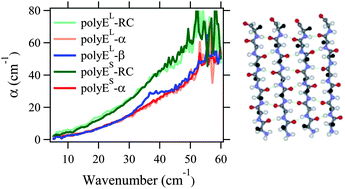Temperature and hydration dependence of low-frequency spectra of poly-l-glutamic acid with different secondary structures studied by terahertz time-domain spectroscopy
Abstract
We have investigated low-frequency

* Corresponding authors
a
Molecular Photoscience Research Center, Kobe University, 1-1 Rokkodai-cho, Nada, Kobe, Japan
E-mail:
tominaga@kobe-u.ac.jp
Fax: +81 78 831 5679
Tel: +81 78 831 5679
b Research Center for Development of Far-Infrared Region, University of Fukui, 3-9-1 Bunkyo, Fukui, Japan
c Graduate School of Science, Kobe University, 1-1 Rokkodai-cho, Nada, Kobe, Japan
d Institute for Molecular Science, Myodaiji, Okazaki, Japan
We have investigated low-frequency

 Please wait while we load your content...
Something went wrong. Try again?
Please wait while we load your content...
Something went wrong. Try again?
N. Yamamoto, O. Kambara, K. Yamamoto, A. Tamura, S. Saito and K. Tominaga, Soft Matter, 2012, 8, 1997 DOI: 10.1039/C1SM06433A
To request permission to reproduce material from this article, please go to the Copyright Clearance Center request page.
If you are an author contributing to an RSC publication, you do not need to request permission provided correct acknowledgement is given.
If you are the author of this article, you do not need to request permission to reproduce figures and diagrams provided correct acknowledgement is given. If you want to reproduce the whole article in a third-party publication (excluding your thesis/dissertation for which permission is not required) please go to the Copyright Clearance Center request page.
Read more about how to correctly acknowledge RSC content.
 Fetching data from CrossRef.
Fetching data from CrossRef.
This may take some time to load.
Loading related content
